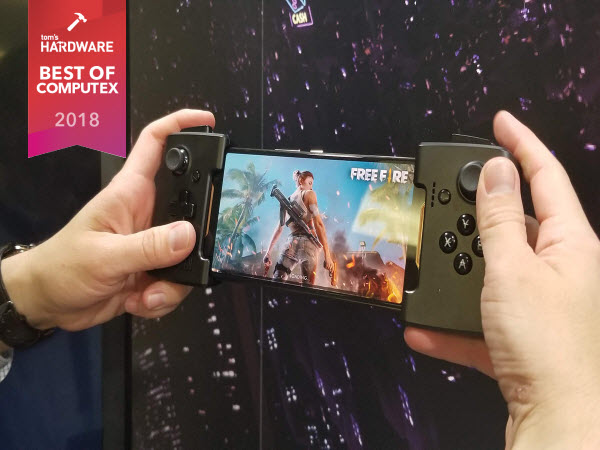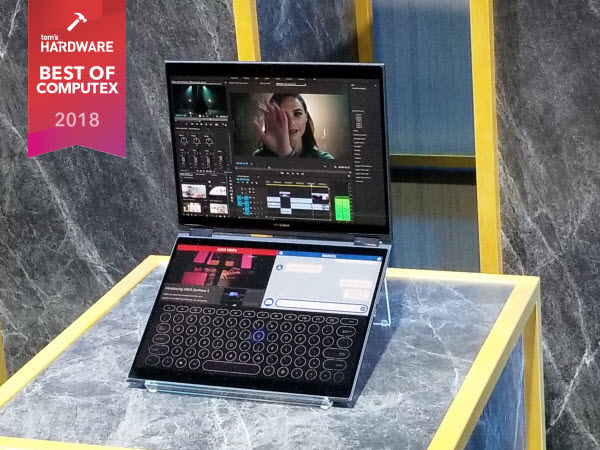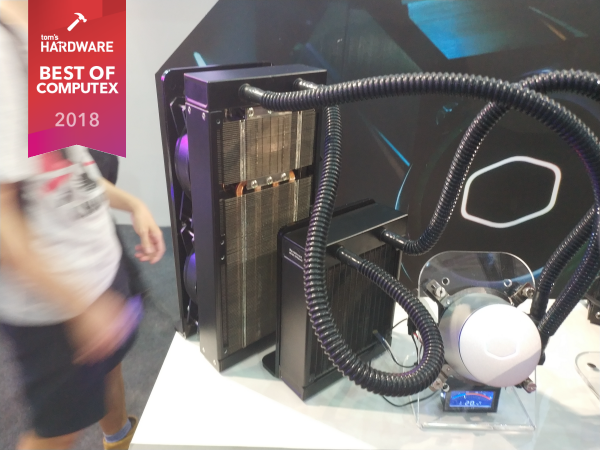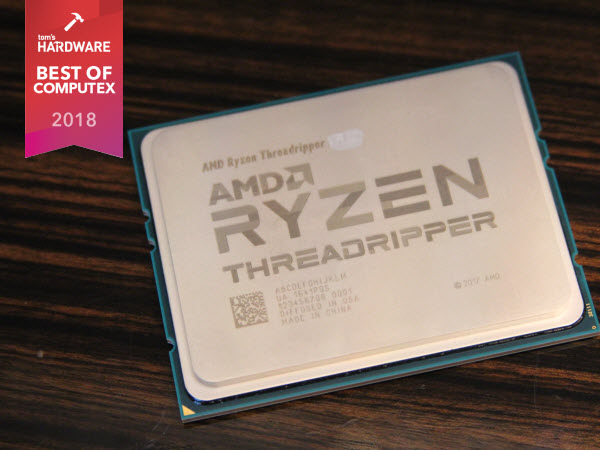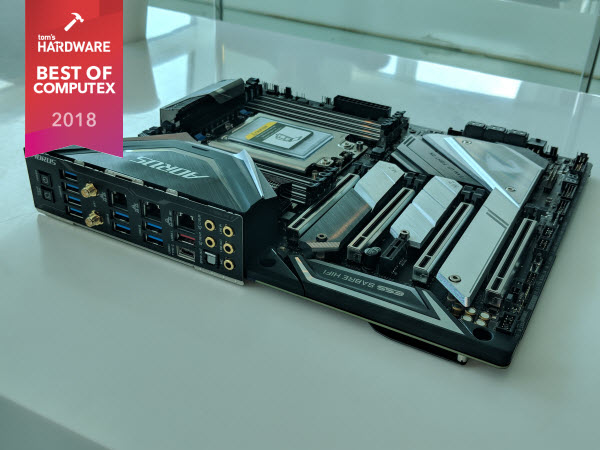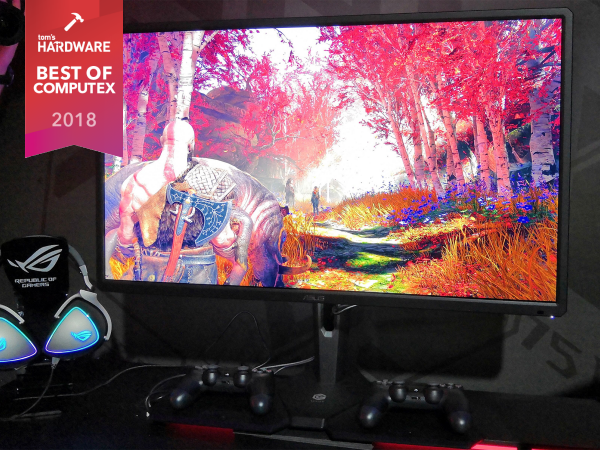Best Of Computex 2018
Best Of Computex 2018
This year, Computex was quieter than usual as neither Intel nor Nvidia issued major platform releases and, accordingly, OEMs rolled out fewer new PCs. However, at a comparatively quiescent show, truly great products stand out even more.
Our favorites from Computex 2018 include a shape-shifting chassis, a dual-screen laptop that's powered by A.I. and a CPU with a whopping 32 cores. We even fell in love with a gaming-centric smartphone. While some are waiting for a GTX 1180 card or another generation of Intel CPUs, these innovative devices give us plenty of reasons to be excited about the future of PCs and the tech industry as a whole.
Best Gaming: ROG Phone
Razer may have beaten Asus to the gaming-phone punch by several months. But the ROG Phone hits back hard with a half-terabyte of storage, a 90Hz AMOLED screen, and a speed-binned Snapdragon chip with active cooling.
Throw in a slew of impressive gaming accessories, and you have a phone for gamers and enthusiasts that easily lives up to the expectations of the ROG brand. We expect the asking price to be high, Just like ROG motherboards,. But if you just can’t stop playing Fortnite while you’re out and about in meatspace, the ROG Phone will be tough to beat.
Best Innovation: Asus Project Precog
No, this futuristic, dual-screened notebook can't predict crimes, but its Movidius A.I. chip has a really good idea about where you'll place your fingers (for typing on the virtual keyboard) or when to maximize battery life, based on your meeting schedule. By replacing the physical keyboard and touchpad with a second display, the Precog allows you to, for example, view a video on the bottom while you work on the top.
Because the screens bend back 360 degrees, you can transform the Precog into a book, or use it in tent mode. Asus's Precog is just a prototype for now, but its full-size touch displays and predictive capability makes it look like a vision from the future.
Best Cooling: Cooler Master’s TEC-Hydro Cooling
Thermoelectric/Peltier coolers have never quite taken off in the enthusiast cooling space, despite their impressive chilling potential. That’s at least in part due to their tendency to introduce moisture (via condensation) to your sensitive CPU area. Cooler Master’s TEC-Hydro Cooler gets around that problem by using the technology’s chilling abilities not on the CPU, but on the liquid inside the closed-loop cooler, which is then circulated to cool your processor.
Get Tom's Hardware's best news and in-depth reviews, straight to your inbox.
The company says the TEC-Hydro should be able to handle around 300 watts of heat dissipation. That’s more than enough for most high-end CPUs. But we’re eager to test the system’s cooling capabilities against one of AMD’s upcoming 32-core Threadripper 2 chips. If it can tame 64 threads of overclocked AMD, then thermoelectric cooling might just be here to stay.
Best Memory: Aorus RGB LED DDR4-3200 memory kit
Gigabyte debuted its first-ever desktop memory in the form of a 16GB (2x8GB) kit of Aorus-branded RGB LED DDR4-3200. The company also ships the memory with two additional light-up “dummy” modules that allows users to fill all of the DIMM slots on a dual-channel motherboard to give your build a uniform look. While some might balk at non-functioning memory sticks, in our current world of expensive RAM, we think Gigabyte is on to something here. Could dummy graphics cards be next to fool people into thinking you're a big SLI spender?
Best Chassis: Riotoro Project Morpheus
In a PC case world awash in tempered glass and RGB, Riotoro’s Project Morpheus chassis stands out for its ability to grow along with your build—literally. It can change shape to accommodate micro-ATX builds with modest components, or full-sized ATX systems with multiple graphics cards and fast PCIe storage. And with perforated mesh adorning almost every surface, you should have no problem keeping your components cool without having to crank up the fan speeds.
Best Power Supply: Cooler Master XG Gold 750
If your power supply could talk, what would it tell you? The upcoming XG Gold 750 from Cooler Master is one of the first power supplies that can tell you how it is doing. The component comes with a built-in LED screen that shows bar graphs for its current temperature and power load. With 750 watts of power and a seven-year warranty, this also seems like a really good PSU under the hood.
Best SSD: Intel 905P M.2 (380GB)
Intel finally unleashes Optane with all of the boxes checked for enthusiasts users. Form factors matter! With no cables to get in the way or the need to cannibalize a PCIe slot, the ultimate Optane SSD has arrived. The new 905P M.2 delivers a 3x capacity increase over the existing 800P M.2 SSD and the performance of the exotic add-in cards to give users an uncompromised high-speed storage solution.
Best CPU: AMD Threadripper 2
AMD faces the momentous challenge of delivering a worthy follow-up to the first-gen Threadripper processors. The company’s second-gen Threadripper processors tackle that in the best way possible: more cores.
The new Threadripper chips set another new record for the high-end desktop, with up to 32 cores and 64 threads. They bring the goodness of the Zen+ architecture, which includes a new revamped 12nm+ process, faster frequencies across the board, and reduced cache and memory latencies. This potent combination has already driven the 2000-series Ryzen processors to new heights, and we expect similar results when the second-gen Threadripper processors come to market in Q3 2018.
Best Motherboard: X399 Aorus Xtreme
Gigabyte teased a new motherboard for AMD’s new Threadripper 2 processors called the X399 Aorus Xtreme. Between the aluminum backplate (which covers the entirety of the E-ATX board), copper VRM heatsinks, a removable BIOS chip, and reduced RGB lighting (compared to other Aorus-branded boards), it’s one of the heaviest, most full-featured, and elegant motherboards we’ve ever seen.
Best Monitor: Asus CG32UQ
Asus’ CG32UQ monitor is aimed not at PC players, but console enthusiasts. The 31.5-inch 4K panel sports a bed in the base to stow and charge your controllers, 600 nits of brightness and HDR10 support, variable-refresh between 40-60Hz, and an Ambilight-like Halo Sync feature, which uses 38 LEDs behind the display to match your room lighting with what’s happening on the screen.
Sure, it’s designed for console gamers, but with all those enticing features, it would certainly work well when paired with a PC. And with three HDMI and a DisplayPort, there’s no reason you couldn’t connect every modern console and your gaming PC.
Tom's Hardware is the leading destination for hardcore computer enthusiasts. We cover everything from processors to 3D printers, single-board computers, SSDs and high-end gaming rigs, empowering readers to make the most of the tech they love, keep up on the latest developments and buy the right gear. Our staff has more than 100 years of combined experience covering news, solving tech problems and reviewing components and systems.

